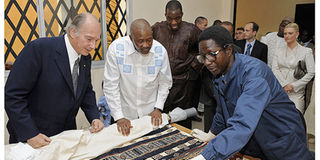New park changes face of Mali capital

PHOTO | AKDN: His Highness the Aga Khan (left) and President Amadou Toumani Toure of Mali (second left) review tapestry work being restored in a new conservation lab built under an agreement between the National Museum of Mali and the Aga Khan Trust for Culture. The lab is dedicated to organising the museum’s reserve collections of and expanding the its restoration capabilities.
What you need to know:
- It creates a permanent green space in one of Africa’s fastest growing cities
Bamako, Saturday
Mali marked its 50th independence celebrations a week ago and one of the events lined up was the inauguration of a new park in its capital, Bamako.
The 250-acre National Park of Mali was created under a public-private partnership between the government of Mali and the Aga Khan Trust for Culture (AKTC).
And on hand during its inauguration were Mali’s President Amadou Toumani Toure and His Highness the Aga Khan, who were also joined by visiting heads of state from across Africa.
The park creates a permanent green space in one of the fastest growing cities in Africa.
Under the terms of the public-private partnership, the government asked AKTC to concentrate on the park’s 250 acres, a large, semi-circular canyon of protected forest that lies beneath the Koulouba plateau, between the National Museum and the Presidential Palace Complex.
The park is part of a larger protected forest reserve of 5,180 acres.
In keeping with AKTC’s philosophy that a park without a long-range plan for maintenance and development could simply become a burden on the city, AKTC earlier signed a 25-year agreement with Mali’s Minister of Culture and Minister of the Environment and Sanitation for the maintenance and further development of the park.
AKTC’s park projects, notably in Delhi, Cairo and Zanzibar, all have provisions for the long-term sustainability of the parks.
The park is designed to offer large open spaces for leisure and educational activities for the general public, school groups and tourists.
Bringing together the National Museum and the existing Botanical Garden and Zoo into a single cultural/ecological park, the park features a comprehensive pedestrian circulation network and formal promenades.
It contains jogging tracks
It contains fitness, jogging, cycling and mountaineering tracks of varying difficulty and diverse interpretive awareness trails for botany, birds and nature.
The garden spaces feature indigenous flora in varied settings, from open lawn areas to flower gardens, wooded areas and a medicinal garden.
Interpretive educational signs and displays and the development of trained guides are expected to offer new educational experiences for visitors.
Phase 1 included the rehabilitation of 17 hectares of open spaces and the redevelopment and integration of eight existing facilities.
The architect, Diébédo Francis Kéré, an Aga Khan Award for Architecture recipient in 2004, was commissioned to design a primary and secondary gate, an entry building, a youth and sports centre, a restaurant, public toilets and several kiosks.
The park development is part of a broader programme of urban revitalisation efforts undertaken by AKTC at World Heritage sites within the country.
As part of its Earthen Architecture Programme, AKTC has also undertaken large cultural, social and economic projects in Mopti, Timbuktu and Djenné.
The programme began in 2006 with the restoration of the Great Mosque of Mopti, which had been at risk of collapse.
AKTC then implemented an urban regeneration programme that aimed to raise the standard of living for residents in the Komoguel area.
Following the work in Mopti, AKTC initiated comprehensive conservation works on the Djingereyber Mosque in Timbuktu at the end of 2006.
The mosque, built in the 14th century, is the oldest earth construction building in sub-Saharan Africa. Officially listed as part of the Mali’s cultural heritage, it was designated a World Heritage Site by Unesco in 1988.
AKTC’s work in Djenné began in 2006, when a preliminary study of the Great Mosque revealed that despite its well-known annual maintenance process, the Great Mosque of Djenné was at risk of collapsing.
AKTC’s conservation of the Mosque, which began at the end of 2008, encompassed the complete rehabilitation of the roof, restoration of the mud-brick load-bearing wall structure and the complete replacement of the interior lighting, ventilation and sound systems.
As in Mopti, Djenné’s Phase 2 will encompass the improvement of public spaces, the installation of water and sanitation and other measures designed to improve the quality of life in the area. (AKDN).




